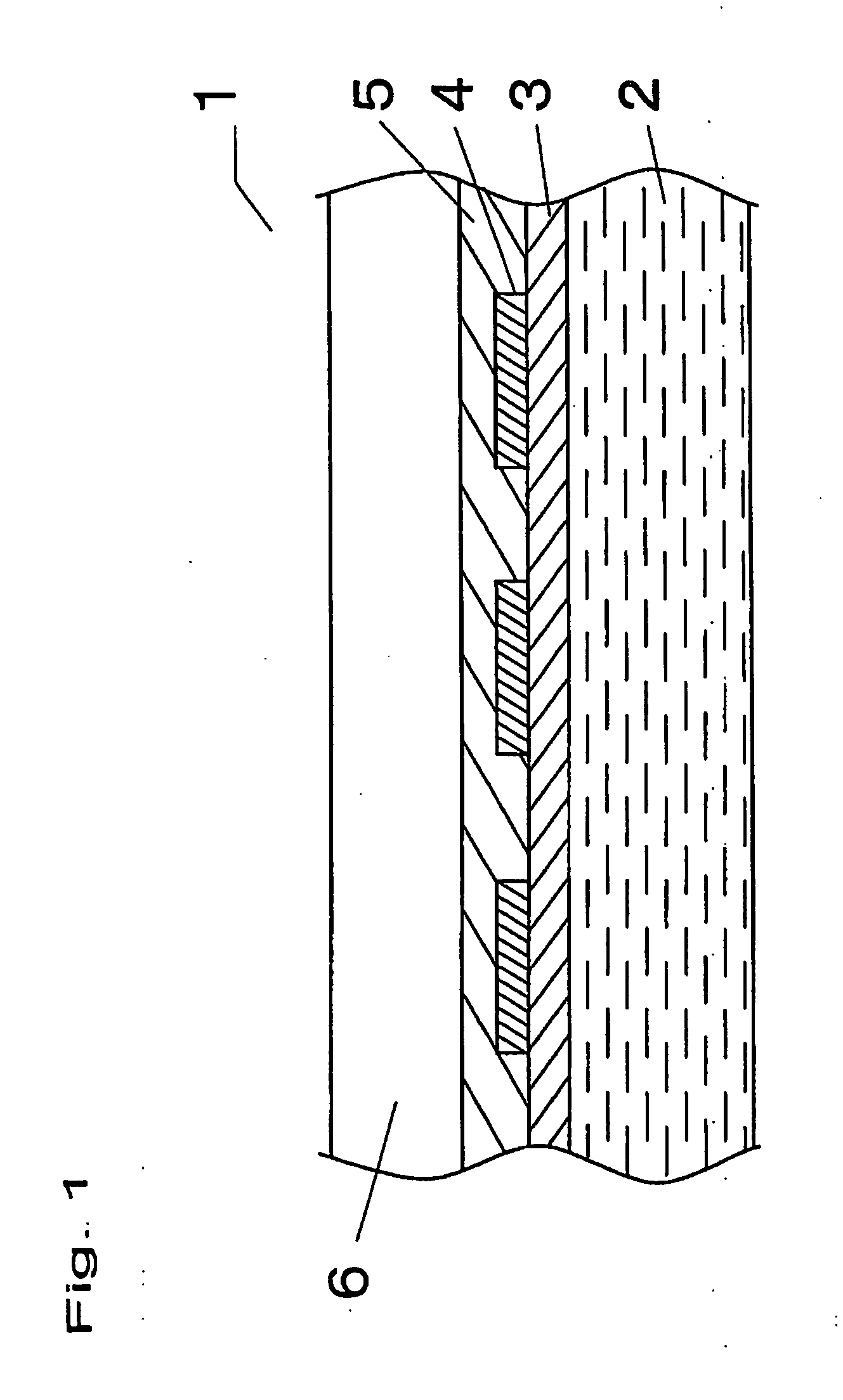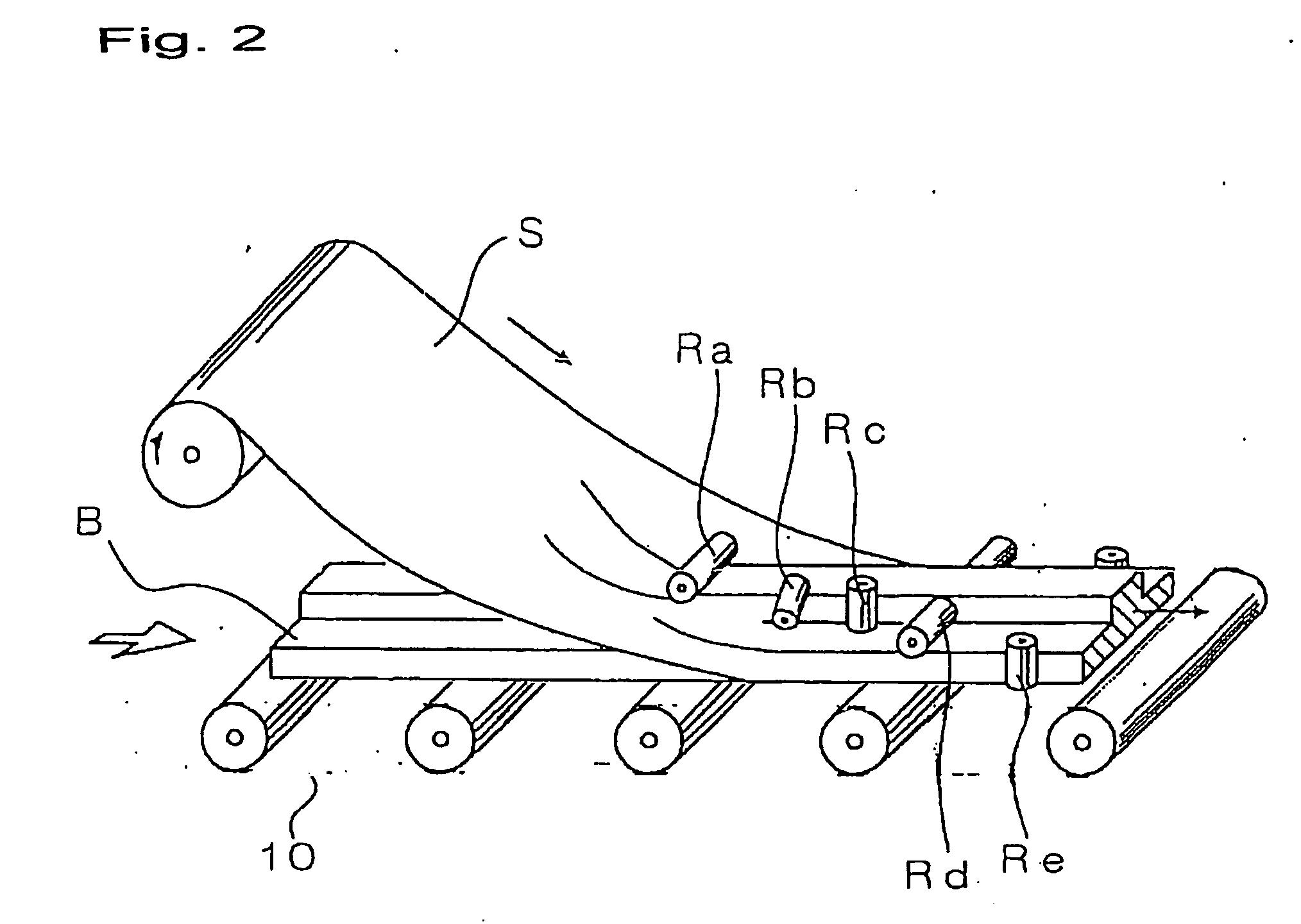Decorating material
a technology of decorative materials and surface properties, applied in the field of decorative materials, can solve the problems of variable limitations in the production of decorative materials, and achieve the effect of improving the processability of decorative materials and excellent surface properties
- Summary
- Abstract
- Description
- Claims
- Application Information
AI Technical Summary
Benefits of technology
Problems solved by technology
Method used
Image
Examples
example 1
[0087] Using an ordinary paper for building materials having a basis weight of 30 g / m2 as the substrate 2, a whole solid printing layer having a coating amount of 17 g / m2 was formed on one surface of the substrate with an urethane-based ink containing nitrocellulose as a binder by a gravure printing method, thereby forming a colored layer 3. Then, a penetration-preventing layer 5 (primer layer) was formed on the colored layer 3 using an acrylic ink.
[0088] Next, an electron beam-curable resin composition composed of 60 parts by mass of ethyleneoxide-modified trimethylolpropane ethyleneoxide triacrylate as a trifunctional acrylate monomer, 40 parts by mass of dipentaerythritol hexaacrylate as a hexafunctional acrylate monomer, 2 parts by mass of silica particles having an average particle size of 5 μm and 1 part by mass of a silicone acrylate prepolymer was applied in a coating amount of 5 g / m2 on the penetration-preventing layer 5 (primer layer) by a gravure offset coater method. Af...
example 2
[0089] The same procedure as in Example 1 was repeated except that the exposure dose of the electron beam irradiated was changed to 50 kGy (5 Mrad), thereby obtaining a decorative material. The thus obtained decorative material was examined to evaluate the above properties. The results are shown in Table 1.
example 3
[0091] Using an interlaminar-reinforced paper for building materials having a basis weight of 60 g / m2 as the substrate 2, a (whole surface solid) layer having a coating amount of 6 g / m2 was formed on one surface of the substrate with a nitrocellulose-based ink containing an acrylic resin as a binder by a gravure printing method, thereby forming a colored layer 3. Using an alkyd-based ink containing nitrocellulose as a binder, gravure printing was conducted to form a pattern layer 4 with a woodgrain pattern on the colored layer 3. Then, a butyral / urethane-based ink was gravure-printed in a coating amount of 1 g / m2 over a whole surface of the underlying layers to form a penetration-preventing layer 5 (primer layer).
[0092] Next, an electron beam-curable resin composition composed of 60 parts by mass of ethyleneoxide-modified trimethylolpropane ethyleneoxide triacrylate as a trifunctional acrylate monomer, 40 parts by mass of dipentaerythritol hexaacrylate as a hexafunctional acrylate ...
PUM
| Property | Measurement | Unit |
|---|---|---|
| Fraction | aaaaa | aaaaa |
| Irradiation dose | aaaaa | aaaaa |
| Acceleration voltage | aaaaa | aaaaa |
Abstract
Description
Claims
Application Information
 Login to View More
Login to View More - R&D
- Intellectual Property
- Life Sciences
- Materials
- Tech Scout
- Unparalleled Data Quality
- Higher Quality Content
- 60% Fewer Hallucinations
Browse by: Latest US Patents, China's latest patents, Technical Efficacy Thesaurus, Application Domain, Technology Topic, Popular Technical Reports.
© 2025 PatSnap. All rights reserved.Legal|Privacy policy|Modern Slavery Act Transparency Statement|Sitemap|About US| Contact US: help@patsnap.com


